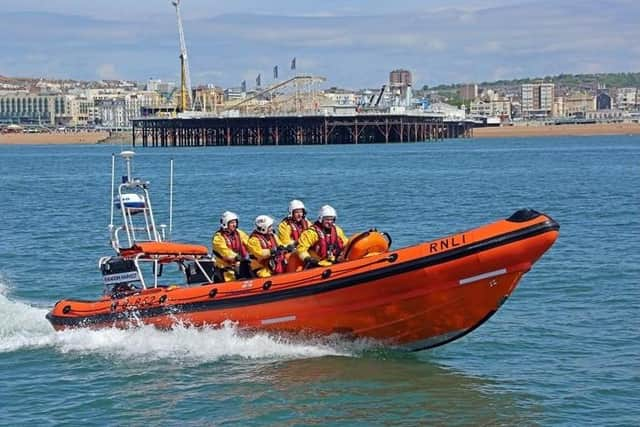RNLI issue warning about jumping into sea from height after pair have lucky escape in Brighton
and live on Freeview channel 276
The volunteer crew was called at 6.07pm on Thursday, July 14 to reports of two people in trouble after jumping off the west side of Brighton Palace Pier near the Albion Groyne.
The crew were stood down on route when it was confirmed both were okay.
Advertisement
Hide AdAdvertisement
Hide AdBrighton RNLI lifeboat operations manager Roger Cohen MBE said the pair had a lucky escape as there was a low tide at the time.


The charity is taking this opportunity to remind people that ‘tombstoning’ is particularly dangerous as water depth can be unpredictable and alter with the tides.
The water may be shallower than the jumpers think and there are often hidden objects on the seabed.
Other dangers include the shock of cold water and unanticipated currents.
Advertisement
Hide AdAdvertisement
Hide AdRoger said: “Jumping from piers and groynes, known as tombstoning, can be incredibly dangerous at any state of the tide for a number of reasons such as submerged rocks and strong currents.
“We realise that it’s tempting to jump from height into the water, especially with such great weather but submerged items may not be visible and could cause serious injury if you hit them.
“The shock of cold water may also make it difficult to swim and in some places strong currents might sweep you away.”
The RNLI recently issued a warning saying: “Whilst we'd never advocate people jumping from height into the water, if they do, there are things to consider to reduce the risk of injury.”
Advertisement
Hide AdAdvertisement
Hide AdThey said people should take precautions and consider the following:
- Water changes depth with the tide, so the water may be shallower than it looks
- Submerged items may not be visible and can cause serious injury or paralysis if you hit them
- The water can be a lot colder than it looks so the shock of cold water may make it difficult to swim
Advertisement
Hide AdAdvertisement
Hide Ad- Always check for hazards in the water like submerged rocks
- People should never enter the water while under the influence of alcohol, drugs or peer pressure
- Important to check for access because it may be impossible to get out of the water
- Coasteering with a registered company is a safer alternative
Advertisement
Hide AdAdvertisement
Hide AdThe RNLI is also urging anyone visiting the coast this summer to make sure they keep themselves and their families safe.
The RNLI's beach safety advice:
- Visit a lifeguarded beach and swim between the red and yellow flags
- Check the weather forecast, tide times and read local hazard signage to understand local risks
- Keep a close eye on your family – on the beach and in the water – don’t allow your family to swim alone
Advertisement
Hide AdAdvertisement
Hide Ad- If you fall into the water unexpectedly, fight your instinct to thrash around, lean back, extend your arms and legs, and float.
- In an emergency dial 999/112 and ask for the Coastguard
For more information and advice about staying safe, visit https://rnli.org/youth-education/education-resources/videos/safe-near-the-water.